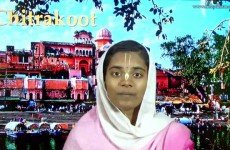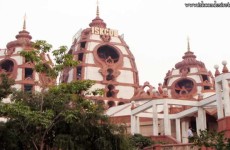Places to Visit in Gaya 1) Phalgu River 2) Vishnupad temple 3) Gadadhar Temple 4) Ram Gaya Sita Kund 5) Akshay Vat 6) Bodh Gaya 7) Mangal Gauri Saktipeeth 8) River Punpun. 1. Phalgu River:- Flowing on the east side of Gaya , Phalgu river carries water only during monsoon. At other time , the river bed is externally dry. However if you scratch some mud you will find water . This means that water flows continuously below river bed. Being cursed by sita devi ,this river runs as under water river below the bed. 2. Vishnupad Temple:- Build with black stone lately in 1780, this age old temple is the most important place to visit in Gaya. Here in this temple you will find the holy foot prints of Lord Vishnu imprinted on stone slab(Story of the Gayasur). Every day at night,this slab of holy footprints is covered by special Malaya Chandan (Sandal Wood) & beautifully decorated with flowers. Red sandal wood is used at the spot where Lord’s foot print carry the symbol of conch,disc,mace & lotus etc .Vishnu sahasranam is chanted with the offering of Tulasi leaf on the holy spot . This is one of very beautiful darshan to behold with ones eyes. 3. Gadadhar Vishnu temple: Next to vishnupad temple just on the banks of Phalgu river is temple of Gadadhar Vishnu. The beautiful black deity is 4 armed form of lord- especially carrying gada (mace) to deliver devotes from evil forces. 4. Ram Gaya and Sita Kunda:- Exactly opposite to Vishnu pad temple but on the other banks of phalgu river is a small temple depicting the spot where sita devi performed pinda dana for her father-in-law. This lila is depicted in form of a beautiful deity of sita devi offering the pinda with sand balls of river phalguni(now phalgu) & hand of Dashrath appearing from the earth to accept it. 5. Akshay Vat:- Located in the very compound of Vishnu pad temple is the famous Akshya vat which was blessed by sita devi to become immortal & never shred its leaves in any season. 6. Mangal Gouri Shakti Peeth: Located on a small hill on the south side of Gaya, is one of famous Sati (Gouri) temple. As mentioned in puranas, Lord Shiva was performing dance of dissolution maddened at the death of his wife sati.To stop this ,Lord Vishnu had to cut the body of sati in to many pieces by his chakra to check Lord Shiva’s further Anger. As the pieces were cut, they fell at different locations and each of this location being turned in to a Shakti Peeth (Holyplace of worship of Gauri). At this place in Gaya, the breast of sati fell. This hill is also known by the name Bhasmakut. Situated close to this hill is Brahma kunda where Lord Gauranga took bath when he came to Gaya. 7. Buddha Gaya or Bodh Gaya: Located 10 km from Vishnu pad temple, is another well-known holy place called Buddha Gaya. A beautiful huge temple with garden complex stands erect in memory of Gautam Buddha. Behind this temple is the Ancient Bodhi tree(Pipal tree) under which Prince Siddharth got his enlightenment & became Buddha. The current tree is an offshoot of the original Bodhi tree.Primarly a holy place for Buddhists follower’s, People from all over the world come here to offer their worship at the holy feet of Lord Buddha. The whole town of Bodh Gaya is well planned & built with many Buddhist monasteries from different South East Asian countries. Nearby is a 30 feet statue of Gautam Buddha in a sitting pose made out of red sand stone. 8. River Punpun – The Punpun River is a tributary of the Ganges. It originates in Palamu district of Jharkhand and flows through Chatra, Aurangabad, Gaya and Patna districts of the Indian states of Jharkhand and Bihar. The Punpun is a sacred river and it is the duty of the pilgrim to Gaya to shave his head on its banks and bathe in its waters on his way to the holy city. It is believed that Lord Vishnu in his fourth incarnation as Lord Vamana put his foot in second stride at confluence of Punpun and Ganga in Fatuha while measuring entire universe in gift from the King Bali. To commemorate this event, a grand rural fair, known as Varuni Mela, is organised annually on the twelfth day of the bright fortnight of Bhadrapada of Vikram calendar (Shukla Paksha Dwadashi of Bhadrapada or Bhado). Incidentally, the same day is celebrated as Onam in southern state of India, Kerala. The Keralite worships arrival of king Mahabali, while in Fatuha the incarnation of Lord as Vamana is celebrated .

















































































